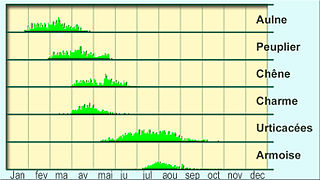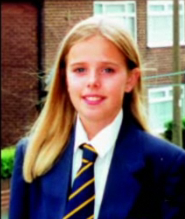
Forensic science, also known as criminalistics, is the application of science principles and methods to support legal decision-making in matters of criminal and civil law.

Forensic palynology is a subdiscipline of palynology, that aims to prove or disprove a relationship among objects, people, and places that may pertain to both criminal and civil cases. Pollen can reveal where a person or object has been, because regions of the world, countries, and even different parts of a single garden will have a distinctive pollen assemblage. Pollen evidence can also reveal the season in which a particular object picked up the pollen.

Patricia Cornwell is an American crime writer. She is known for her best-selling novels featuring medical examiner Kay Scarpetta, of which the first was inspired by a series of sensational murders in Richmond, Virginia, where most of the stories are set. The plots are notable for their emphasis on forensic science, which has influenced later TV treatments of police work. Cornwell has also initiated new research into the Jack the Ripper killings, incriminating the popular British artist Walter Sickert. Her books have sold more than 100 million copies.

Henry Chang-Yu Lee is a Chinese-American forensic scientist. He founded the Henry C. Lee Institute of Forensic Science, affiliated with the University of New Haven. He has worked on numerous prominent cases. In July 2023, a federal court found that Lee had fabricated evidence that sent two teens to prison for 30 years.

Trace evidence is created when objects make contact, and material is transferred. This type of evidence is usually not visible to the eye and requires specific tools and techniques to be obtained. Due to this, trace evidence is often overlooked, and investigators must be trained to detect it. This type of evidence can link a victim to suspects and a victim or suspect to the crime scene.

The CSI effect describes the various ways in which the exaggerated portrayal of forensic science on crime television shows such as CSI: Crime Scene Investigation influences public perception. The term was first reported in a 2004 USA Today article describing the effect being made on trial jurors by television programs featuring forensic science.

Helle Crafts was a Danish flight attendant who was murdered by her husband, Eastern Air Lines pilot Richard Crafts. Her death led to the state of Connecticut's first murder conviction without the victim's body.

Forensic biology involves the application of biological principles and techniques within the context of law enforcement investigations.
The following outline is provided as an overview of and topical guide to forensic science:

Amanda Marie Knox is an American author, activist, and journalist. She spent almost four years incarcerated in Italy following her wrongful conviction for the 2007 murder of Meredith Kercher, a fellow exchange student with whom she shared an apartment in Perugia. In 2015, Knox was definitively acquitted by the Italian Supreme Court of Cassation.

Tammy Jo Alexander was an American teenage girl who was found murdered in the village of Caledonia, New York on November 10, 1979. She had been fatally shot twice and left in a field just off U.S. Route 20 near the Genesee River after running away from her home in Brooksville, Florida, earlier that year. For more than three decades, she remained unidentified under the names Caledonia Jane Doe or Cali Doe until January 26, 2015, when police in Livingston County, New York, announced her identity 35 years after her death.

Timothy Wilson Spencer, also known as The Southside Strangler, was an American serial killer who committed three rapes and murders in Richmond, Virginia, and one in Arlington, Virginia, in the fall of 1987. In addition, he is believed to have committed at least one previous murder, in 1984, for which a different man, David Vasquez, was wrongfully convicted. He was known to police as a prolific home burglar.

A pollen calendar is used to show the peak pollen times for different types of plant pollen, which causes allergic reactions in certain people.

The Soham murders were a double child murder committed in Soham, Cambridgeshire, England on 4 August 2002. The victims were two 10-year-old girls, Holly Marie Wells and Jessica Amiee Chapman, who were lured into the home of a local resident and school caretaker, Ian Kevin Huntley, who subsequently murdered the children—likely via asphyxiation—before disposing of their bodies in an irrigation ditch close to RAF Lakenheath in Suffolk. The girls' bodies were discovered on 17 August 2002.

The murder of Leanne Tiernan was a high-profile English child murder involving a 16-year-old schoolgirl who was abducted less than one mile from her home on 26 November 2000 while returning from a Christmas shopping trip in Leeds, West Yorkshire, and subsequently murdered. The missing person inquiry which followed was one of the largest in the history of West Yorkshire Police, involving the search of around 1,750 buildings, underwater searches of thirty-two drainage wells, the draining of a two-mile section of a canal and the halting of household waste collections.

Dawn Olanick, previously known as Princess Doe, was an unidentified American teenage decedent from Bohemia, New York, who was found murdered in Cedar Ridge Cemetery in Blairstown Township, New Jersey on July 15, 1982. Her face had been bludgeoned beyond recognition. She was the first unidentified decedent to be entered in the National Crime Information Center. Olanick was publicly identified on the 40th anniversary of her discovery.
Angela Mary Cecilia Gallop is a British forensic scientist.
Lorna Anne Dawson CBE FRSE is professor and head of soil forensics at the James Hutton Institute, Scotland, who is an Expert witness, Chartered Scientist, and registered expert with the National Crime Agency. She won the award of Soil Forensic Expert Witness of the Year in the Corporate INTL 2021 Global Awards for her forensic research solving major criminal cases, including the World's End pub murders. She had won a special Pride of Britain Award by The Daily Mirror in 2017, for her role in solving long standing criminal cases, and her science communications. She is a Fellow of the Royal Society of Edinburgh, Commander of the Order of the British Empire, with international academic recognition.
Margaret Pereira CBE was a British forensic scientist. Pereira, nicknamed "Miss Murder" and "Maggie of the Yard," worked on several forensic cases throughout her career. Most notably, her work helped convict John Bingham, 7th Earl of Lucan in the Lord Lucan nanny's murder case in 1974.

Joseph William Kappen, also known as the Saturday Night Strangler, was a Welsh serial killer who committed the rape and murder of three teenage girls in Llandarcy and Tonmawr, near his home town of Port Talbot, in 1973. Kappen is also suspected of committing a fourth murder in February 1976.












